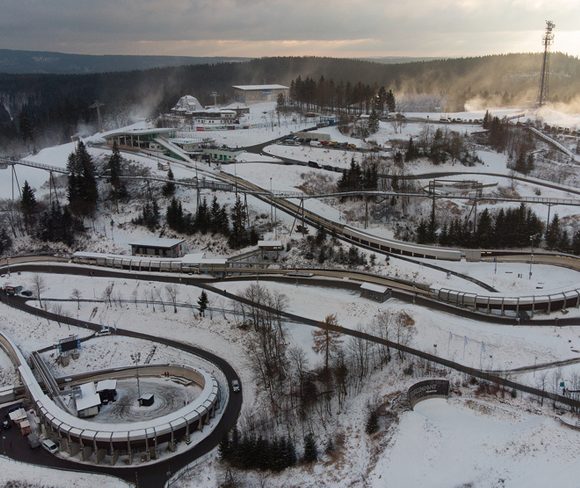The Veltins-EisArena in Winterberg needed to guarantee high performance for athletes and for its energy consumption. Fujitsu provided the loT technology to make this vision happen.
Challenge
Winter sports like bobsleigh, luge, and skeleton are hugely popular but operating and cooling the track consumes a huge amount of energy. The Veltins-EisArena in Winterberg needed to reduce the energy consumption associated with ice rink cooling for sustainability and cost based reasons.
Solution
Fujitsu provides sensors to measure the thickness of ice as well as environmental factors such as humidity, temperature and light. All data is fed back into a Fujitsu IoT Operations Cockpit via the cloud. A digital ice rink is shown on a dashboard. Areas that are too thick or too thin are visually highlighted so that ice can be applied or removed in a targeted manner.
Outcomes
- The ice thickness can now be precisely determined, and the cooling elements can be controlled more efficiently.
- This results in energy savings of 10 percent per reduced centimeter of ice thickness as well as ideal conditions for the athletes.
Top athletes will pay attention to every centimeter they can get so I also do whatever I can to make the track faster. It is has been a huge help that Fujitsu takes on complex problems and brings us solutions and expertise we were never aware of.
Ingo Götze, Ice Master Winterberg Sports Center
About the customer
The Veltins-EisArena in Winterberg is one of four German artificial ice rinks for bobsleigh, skeleton and luge sports. In addition to training, national and international top-class sporting events such as world championships and world cups take place there.
High performance for athletes and energy
The Veltins-EisArena is one of four artificial ice rinks in Germany. The ice is created by cooling down a concrete channel with ammonia. The thinner the ice, the safer it is for athletes to travel down the track, as Ingo Götze, Ice Master Winterberg Sports Center explains: “The challenge for the track team is to keep the ice as thin as possible consistently along the entire length of the track. It’s like skating in an ice rink when the
ice is perfectly flat.”
To provide the perfect ice conditions is the goal, but there are two major cost drivers: Staffing and energy consumption. As Stephan Pieper, Joint CEO Winterberg Sports Center adds: “With every centimetre of ice reduction we can save about 10% in energy costs. With current electricity prices, 10% equates to about 40 to 50 thousand Euros a year. We have to use weather data to try to estimate how the weather will affect the ice cover, so that our team can keep the ice on the track as thin as possible.”
Precision control with IoT sensors
The VELTINS-EisArena wanted to save money, and become more sustainable. But manually measuring ice thickness is very labor intensive, and almost impossible to do at scale. Fujitsu developed an innovative approach, as Dr. Klaus Drathen comments: “We talked to Fujitsu about a variety of issues relating to our track operations and that’s how we started discussing our energy usage and the question of measuring the thickness of the ice.”
Fujitsu then suggested using IoT sensors to measure the thickness of ice with far greater accuracy, as Ingo Götze explains: “The Fujitsu sensors measure to an accuracy of millimeters, and that helps me to decide at what point we have to go back to work on the ice.”
Thanks to the new process, the entire web is no longer permanently cooled. Instead, if the relevant metrics are exceeded or not met, a notification is sent to the ice master, who can then apply or remove ice accordingly. This avoids the thickness of the ice layer increasing unnecessarily and using too much energy for cooling. Considerable savings of up to 10% have been achieved in this way. Despite the thinnest possible ice cover, the precise adjustments continue to guarantee ideal conditions for the athletes.
10% energy savings combined with superior conditions
The relentless focus on detail delivers clear outcomes. Ingo Götze, Ice Master, Winterberg Sports Center explains: “Top athletes will pay attention to every centimeter they can get so I also do whatever I can to make the track faster. It has been a huge help that Fujitsu takes on complex problems and brings us solutions we were never aware of. We all worked together in a well moderated and focused co-design workshop to develop this solution.”
The operating company has ambitious plans for the future. Dr. Klaus Drathen adds: “Our goal is to continue to work with Fujitsu on these problems and create standardized solutions, not only for the operation of our track, but for the three other artificial ice tracks in Germany. Ultimately, our goal is to set the standard for all 17 artificial tracks that are operated worldwide.”




